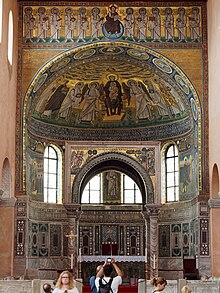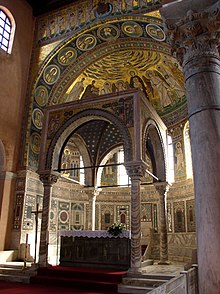Euphrasian basilica
| Episcopal complex of the Euphrasian Basilica in the old town of Poreč | |
|---|---|
|
UNESCO world heritage |
|

|
|
| View of Poreč and the city beach over the east aisle |
|
| National territory: |
|
| Type: | Culture |
| Criteria : | (ii) (iii) (iv) |
| Surface: | 1.1 ha |
| Reference No .: | 809 |
| UNESCO region : | Europe and North America |
| History of enrollment | |
| Enrollment: | 1997 (session 21) |
The Euphrasian Basilica in Poreč is the cathedral of the Croatian diocese of Poreč-Pula with the title of a minor basilica . The church, built in its present form in the 6th century, is one of the most important sacred buildings in Croatia. Because it was hardly changed in later times, it is one of the most important examples of late antique and early Byzantine art in the entire Adriatic region; In 1997 it was added to the UNESCO World Heritage List .
The basilica is named after Bishop Euphrasius , who had the church built between 543 and 554 using parts of the previous building. The basilica and the complex of ecclesiastical buildings surrounding it (atrium, bishop's palace, chapter house, etc.) are located in the north of the small peninsula, which is occupied by the old town of Poreč.
Building history
In the place of the later church there was a modest oratory around 300 , which was part of a large Roman private house. In 313 the martyr Mauro of Poreč was buried there. The oratory was extended to a two-aisled hall (basilicae geminae) in the 4th century. Floor mosaics with the fish as a symbol of Christ have been preserved from this second phase. They can be dated to the time of Emperor Valens (365–378) or a little later through coin finds . The mosaics contain the names of donors with numbers of the respective donated area.
A new church was built in the 5th century. The now three-aisled basilica also included parts of the previous building. As was common in Istria and Noricum at that time, the building has no apse . This church was so dilapidated in the middle of the 6th century that the then Bishop Euphrasius decided to demolish and rebuild. With the dedication inscription and his image as donor on the mosaics in the large apse, Euphrasius set himself a monument.
Parts of the previous buildings were used again. The walls on the north, west and south sides as well as the bases of 18 columns in the interior were integrated. Innovations were the three apses that close off the main aisles and the side aisles to the east.
Furnishing
The furnishings reached a very high level with expensive imported marble, rich mosaics and stucco as well as inlays made of stone and mother-of-pearl , as well as elaborate capitals.
Floor mosaics
There are still mosaics from the previous buildings of the Euphrasius Basilica. On the east side there is a mosaic with meander ornaments, in the upper edge of which two small mosaic blocks with fish are inserted. The four round holes in the mosaic come from altar columns. The larger second field, also decorated with meanders, frames a rectangle with a kantharos from which lush leaf tendrils grow. The parts of the floor mosaic that are under the north aisle of the basilica and extend to the row of columns in the north acade are in fair condition. On top of this first layer of mosaics was another layer which, with the exception of the subsellium, where a carefully executed tendril can be found, is of less quality.
Wall mosaics
There was also a mosaic on the face of the Euphrasian basilica, which has hardly survived. In addition to tendrils and flowers, the pictorial program includes a depiction of Christ enthroned on the vault of heaven, four sources (representing the four rivers of Paradise), the twelve apostles and the seven apocalyptic candlesticks.
The front wall of the apse is framed by a narrow, ornamented band. In the narrow field above the triumphal arch the young Christ sits on the vault of heaven. In the book in his hand is Ego sum lux vera. He is surrounded by the twelve apostles with various attributes and their names. The lower arch of the mosaic is adorned with medallions separated by inscriptions. Next to Christ as the Lamb of God, there are six saints on each side.
The upper vault of the apse contains Mary with the baby Jesus ( Nicopoia ), surrounded by angels and martyrs, the bishop Euphrasius and the deacon. Mary is seated on a throne covered by a pillow. Two angels stand on both sides, showing the way for those arriving. One group consists of martyrs with halos, the other of Maurus, Euphrasius and the archdeacon Claudius. Between Euphrasius and Claudius stands a child with the inscription Euphrasius, son of the archdeacon. The figures stand on a meadow overgrown with flowers.
Under the dedication next to the windows there are five mosaic areas with the following content: The Annunciation is depicted on the north side. An angel raises his hand as a sign of the preaching. In the left he is holding a messenger staff. Maria wears a purple dress and a veil. She is holding yarn in her left hand. On the south side, Maria meets Elisabeth. Both wear a priestly robe of the time with a cloak made of ribbons. Behind Elisabeth you can see a small house, the curtain of which is being pushed aside by a small woman. The three smaller fields are adorned by John the Baptist, an angel and Zacharias.
The picture shown in both apses shows the young Christ with a halo, who puts the martyr's crown on two martyrs . In the north apse are probably Cosmas and Damianus, in the south apse Ursus (or another Ravennatic bishop) and Severus.
Stucco
The underside of the arches of the northern nave arcades is provided with stucco patterns, some of which contain motifs from the animal and plant kingdom. The stucco shows traces of a colored version.
Incrustations
The entire lower part of the apse is decorated with incrustations of colored stone slabs and mother-of-pearl. Parts of the paneling come from an earlier wall paneling, which, as finds show, was more finely worked. The wall decoration consists of 21 fields with 11 combinations of ornaments. Candlesticks and a cross are depicted behind the bishop's throne.
Other buildings in the area
The complex around the Euphrasius Basilica includes the atrium in front of the narthex of the church , a baptistery , the bishop's palace and a small chapel, all of which were also built by Bishop Euphrasius in the 6th century. In 1257 a house for the canons of the cathedral was added, a sacristy was added in the 15th century and the bell tower was built in the 16th century.
Remarks
- ↑ A preserved inscription provides information about this : Hoc Cubile Sanctum confessoris Mauri nibeum contenet corpus haec primitiva a eius oratibus reparata est ecclesia hic condigne translatus est ubi episcopus et confessor est factus ideo in honore duplicatus est locus ...
-
↑ HOC FVIT IN PRIMIS TEMPLVM QVAS SANTE RVINA. TERRIBILIS. LABSV. NEC CERTO ROBORE FIRMVM-EXIGVVM. MAGNOSQVE. CARENS. TVNC. FVRMA METALLO SED MERITIS TANTVM. PENDEBANT PVTRIA TECTA + VT VIDIT SVBITO LABSVRAM PONDERE SEDEM PROVIDVS ET FIDEII FERVENS. ARDORE, SACERDVS EVFRASIVS SCA PRECESSIT - MENTE RVINAM LABENTES MELIVS SEDITVRAS DERVIT AEDES FVNDAMENTA LOCANS EREXIT CVLMINA TEMPLI + QVAS CERNIC NVPER VARIO FVLGERE METALLO PERFICIENS COEPIT. MAGNO AECCLESIAM VOCITANS SIGNAVIT NOMINE XPI CONGAVDENS OPERI SIC FELIX VOTA PEREGIT
This was initially a shattered and dilapidated house of worship that threatened to collapse and was not fortified with certain strength, it was narrow and not adorned with gold, and its defective roof was adorned by grace alone . When the precautionary and faithful priest Euphrasius saw that his seat was in danger of collapsing under the load, he holy intentions prevented it from collapsing, and in order to better fortify the dilapidated building, he tore it off and after he laid the foundations had laid, he built the gable of the church. What you will soon see shimmering in gold, (he) adorned by completing what was started and giving it gifts in its size. Calling on the name of Christ, he consecrated the Church and so happily fulfilled his vow while rejoicing in the work.
literature
- Milan Prelog: The Euphrasius Basilica in Porec. Zagreb & Porec 1994.
- Gabriella Bernardi: I mosaici della basilica eufrasiana di Parenzo. Documenti per la storia dei restauri (1862-1916). Rovigno & Trieste 2006.
- Ante Sonje: Il Palazzo vescovile del complesso edilizio della Basilica eufrasiana di Parenzo. In: Atti. Centro di ricerche storiche Rovigno. 26, 1996, pp. 447-488.
Web links
Coordinates: 45 ° 13 ′ 43 " N , 13 ° 35 ′ 37" E







